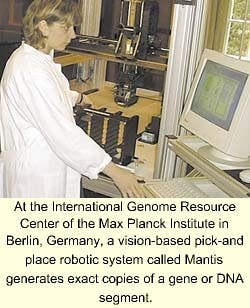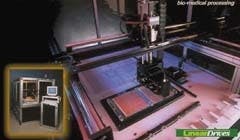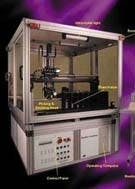Robotic vision speeds DNA analysis
By Joe and Alison Hallett,Contributing Editors
Human genome research is showing improved results due to the adoption of robotic systems that automate and accelerate experimental analysis procedures.
A major objective at the Resource Center of the German Human Genome Project of the Max-Planck-Institute for Molecular Genetics (Berlin-Charlottenburg, Germany) is to generate and distribute high-quality biological materials and to collect experimental data. To accomplish this task, the center builds genomic libraries—collections of genetic materials that are created by cloning, a process in which multiple, exact copies of a gene or a DNA segment are created. These clones are collected into libraries through processes called picking and gridding.
In the picking process, pieces of DNA are inserted into a virus or other cell. This cell is then introduced into a host system such as yeast or bacteria. Next, these systems are spread onto an agar plate and grown into colonies. Selected colonies are then transferred to wells in a microtiter plate that contains a growth medium.
In the past, this picking process was performed manually. A researcher would dip a clean toothpick into a solution and pick up a small amount of material that would then be deposited into a destination, thereby "inoculating" the target. This slow one-at-a-time process has been replaced by a picking robot.
ROBOT REPLACEMENT
Because the process of picking and transferring materials is both repetitive and time-consuming, the Max-Plank Institute approached Linear Drives Ltd. (LDL; Basildon, Essex, England) to develop a robotic system to automate the picking and gridding tasks. As a result, the Mantis Robot system has been developed jointly by KayBee Engineering (Basildon, Essex, England), which performed the framework and the systems integration, and RVSI Acuity CiMatrix (Canton, MA), which supplied the software (see Fig. 1).
FIGURE 1. In the design of the Mantis Robot, engineers from KayBee Engineering mounted a CCD camera to the z-axis of the positioning mechanism. Interfaced to a Macintosh-based digital frame-store card, the robot vision system captures images and then analyzes them using Image Analyst software. Robot control is via an RS-232 serial interface.
A basic Mantis Robot system comprises a three- or five-axis LDL robotic system, a CCD imaging camera, and a computer-control system, complete with turnkey software. Options address only the gridding process or both picking and gridding processes. "Systems cost approximately $100,000 to $250,000," says Bill Luckin, LDL joint managing director.
Adds Guenther Zehetner, researcher at the German Human Genome Project, "Three LDL robots, which each measure 1800 x 1500 x 1800 mm and weigh 800 kg, are in use at the Genome Resource Center, and one is in preparation. The Resource Center has extended the capabilities of the original robot design to include database connection, automatic recovery, and a multilanguage user interface."
Says Steve Nally, KayBee software director, "The robot is relatively maintenance-free. We just test that everything is square and frequently change the ethanol used for sterilization."
Each robot system comprises a linear three-axis-motion "H"-gantry, gridding/picking heads, a vision system and controller, and equipment for the automated handling of sample plates (see Fig. 2). At the core of the robot are LDL's linear actuators. Says LDL sales and marketing manager Rob Houghton, "Linear drives are a form of linear servo motor, controlled in the same way as conventional motors. They can be used interchangeably with other types of linear actuators, simplifying the selection of position servo electronics and control systems. Two parallel linear motors drive the x-axis. Bridging between is the y-axis, a configuration that gives access to the area underneath. The load on the end of the z-axis consists of automated pipette with tubing and weighs 10 to 15 pounds."
Microprocessors help control all three axes along with 5-µm linear optical encoders, which give high accuracy with no backlash. "Accuracy is not critical in the vertical direction, but horizontal accuracy is essential," says Houghton. "The actual move can be from 1/4 in. to about 3 ft full travel while loading or picking samples from microplates."
INTEGRATING VISION
The goal of the robot's vision system is to identify independent colonies of bacteria that are growing in the 22 x 22-cm beds of agar-a nutrient material—and to determine their precise location. Colonies can be as small as 1 mm. Says Zehetner, "Size, gray scale, and roundness are the most important parameters for colony identification. Freedom from contamination is essential. The vision system must determine that each selected colony stands by itself and has not grown into adjacent material by measuring the major and minor axes of each candidate. If they are the same, a round—and therefore independent—colony is presumed."
FIGURE 2. At the core of the Mantis Robot are LDL's linear motors. Two parallel linear motors drive the x-axis. Bridging between the two x-axis drives is the y-axis; this configuration gives access to the area underneath the robot. The load on the end of the z-axis consists of automated pipette with tubing and weighs 10 to 15 pounds.
In developing the vision system, KayBee Engineering mounted a TM6 monochrome 600 x 400-pixel CCD camera from Pulnix America Inc. (Sunnyvale, CA) with a slightly larger than normal lens to the z-axis of the positioning robot. The camera is interfaced to a Macintosh-based digital frame-store card from RVSI Acuity CiMatrix and installed in a Macintosh Quadra 950 computer; captured images are analyzed using Acuity's Image Analyst software. This software controls the x-y-z motion platform, performs image analysis to identify bacterial colonies, and provides a graphical user interface.
Interfacing the vision system to LDL's x-y-z motion-control system is accomplished by linking LDL's controller over a serial link and using Acuity's robotic automation instrumentation motion-control language. With pull-down and task menus, steps such as 'move' or 'take a picture' are accomplished using the graphical user interface.
"Colony picking is vision-based," says Nally. "During operation, the robot's camera looks for colonies at one corner of the tray full of bacterial colonies, taking 100 images (10 x 10) to cover the entire surface. Says Nally, "The robot takes a series of images, at 2 to 3 s/image, recognizes where colonies are, and then picks 96 of them using an array of 96 steel pins, picking one (colony) at a time." It sterilizes the picking head in ethanol. Then, it heater-dries the colonies and returns for 96 more samples. In this way, the robot can pick 3000 colonies per hour.
The system features automatic calibration of all vision and robotic parameters and each pin on every picking head. It can also store and retrieve selected picking parameters and cope with sloping or badly poured agar plates. With a hit rate of greater than 98%, more than 9000 colonies can be picked without user intervention.
Illumination is provided by fluorescent lamps mounted around the robot periphery. To eliminate shadows and stray reflections, black paper is positioned around the sides of the equipment enclosure. Adds Zehetner, "Uniform illumination is essential to recognition. To assist the illumination, the software corrects for background differences."
MATERIAL TRANSFER
Gridding is a hand-free liquid-transfer process. After incubation, colonies of DNA in 96- or 384-well microtiter plates are generated. Up to 72 of these plates can be stored in the robot via an automatic stacker. The genetic material is then transferred (gridded) from these plates to the 22 x 22-cm nylon filters (membranes) with a gridding tool—an array of 384 pins. Each pin dips into one well of a microtiter plate, then moves to its designated position on the nylon fabric sheet and performs a stamping action. By using an interpolation process, the system packing density can be made greater than the center-to-center spacing of the gridder pickup heads.
Gridding densities of up to 230,400 samples per filter can be achieved at a rate of 250,000 samples per hour. Remote monitoring of the process can be carried out using a computer running on a TCP/IP network. A barcode reader keeps track of all the gridded plates, allows a printout of run data, or permits access to local databases. Software to control the gridding operation is provided by National Instruments Corp. (Austin, TX).
The density of clones has increased from fewer than 10,000 clones per filter in 1991 to more than 50,000 clones per filter in 1994, due to the use of robots. Zehetner says, "Distribution of clones on high-density filters via robots allows the distribution of specific libraries to more than 6000 scientists. Results of experiments made in different laboratories can then be compared. With the development of more-sophisticated robots the density of spots on the filters should increase."
Company Information
KayBee Engineering
Basildon, Essex SS14 3HS England
Web: www.kaybee.co.uk
Linear Drives Ltd.
Basildon, Essex SS14 3BW England
Web: www.lineardrives.com
National Instruments Corp.
Austin, TX 78759
Web: www.ni.com
Pulnix America
Sunnyvale, CA 94089
Web: www.pulnix.com
Resource Center German Human Genome Project
Max-Planck-Institute for Molecular Genetics
14059 Berlin-Charlottenburg, Germany
Web: www.rzpd.de
RVSI Acuity CiMatrix
Canton, MA 02021
Web: www.rvsi.com



